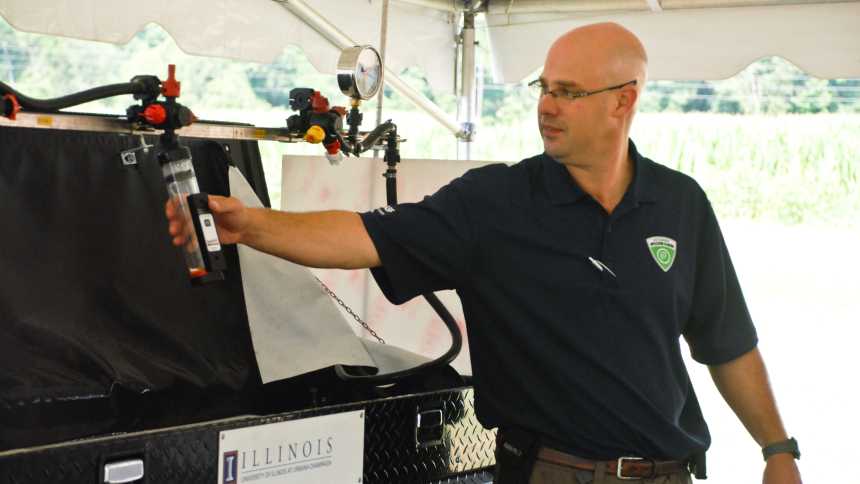Spray Drift Enters More Complex Era

Topics at BASF’s On-Target Application Academy — a half-day, hands-on training session on best herbicide application practices — include nozzle selection, calibration, sprayer set-up and adjuvants.
Off-target movement of crop protection products has been a problem for decades. The issue got more contentious when glyphosate-tolerant crops were introduced 20 years ago: How do applicators protect plants in the next field that can’t handle the herbicide? Now multiple new herbicide cropping systems will ratchet up the challenges even more. Set for commercial-scale launch in the next season or so, the products promise much-needed control of glyphosate-resistant weeds, but come with a host of demands on users.
The systems feature Monsanto’s Roundup Xtend and Extendimax teamed with its Roundup Ready 2 Xtend soybeans and Bollgard II XtendFlex cotton (dicamba tolerant); BASF’s Engenia, also for use on Monsanto’s dicamba-tolerant crops; and Dow AgroSciences’ Enlist Duo paired with its Enlist corn and E3 soybeans (2,4-D tolerant). All three companies say these herbicides’ chemistries have been improved and are now technologically advanced to reduce volatility and drift.
Teaching To The Challenges
Industry researchers, application experts and chemical manufacturers are hurrying to educate growers and retailers on the nuances of the cropping systems. Many of those efforts involve reducing the chance of applications drifting onto non-tolerant crops. Monsanto, Dow AgroSciences and BASF have conducted field training programs covering issues such as mixing and handling, sprayer operation, field awareness and recordkeeping.
BASF has reached out in part through its On-Target Application Academy (OTAA), a half-day, hands-on training session on best herbicide application practices. Topics also include nozzle selection, calibration, sprayer set-up, equipment clean-out, adjuvants and plant biology. OTAA was developed by BASF in partnership with Dr. Bob Wolf of Wolf Consulting & Research LLC and TeeJet. At presstime, more than 6,300 growers and retailers had attended the academy since 2012.
Wolf says attendees are coming from an era of application that, with the use of Roundup, has been simple. “Now we’re moving into an era that’s going to involve more chemistries and tank mixing combinations,” he says.
Changes are needed. For one thing, applicators have long focused intensely on nozzle selection, counting on drift control tips to prevent drift problems or selecting a nozzle type that will ensure coverage for better weed control. They’ve chosen nozzles based on the speed and pressure they want to use while operating machines in the field.
Some applicators may need to adjust practices because droplet size is now the number one concern, says Wolf. “They may have to adjust their nozzle types, speeds and pressures in accordance with that,” he notes.
“They’ve been told for a long time their best option for drift mitigation is to use lower pressure. And in today’s technological era of nozzle designs, low pressure doesn’t always give the best result,” he says. It may create droplets that are too large, so coverage on the target is not good.
“What we’ve learned through research in recent years is those nozzle designs are best operated at higher pressures to make the droplets more uniform for both better coverage — and they still will dramatically reduce drift potential,” says Wolf.
But using those higher spray pressures while at the same time driving at high speeds could still pose a problem. In a conventional rate controller-operated sprayer, the higher speed will typically increase the pressure to ensure the correct application volume (GPA). The result is smaller droplets, which are more drift-prone and offer less coverage. “Applicators run into a scenario where they don’t have the coverage they need to control the targeted pest, and in this case it’s going to be those hard-to kill resistant weeds,” Wolf explains.
Poor coverage means re-spraying may be needed and increased drift means the chance of a drift control complaint — both costly outcomes.
Another factor to consider in the field: boom height. Some drivers have been raising booms a little higher than they need to be because they’re operating at faster speeds, says Wolf. They run high because they’re concerned about running the boom into the crop or ground, tearing it up. The problem there is the higher the boom goes, the more exposure sprays have to the wind and hence, tendency to drift.
Drivers are going to have to slow down, says Wolf. He admits that goes against the “bottom line” principle in many applicators’ minds right now.
Manufacturer Weighs In
Chad Brommer, herbicides technical market manager at BASF (Engenia) acknowledges that it’s a challenge from the company’s standpoint to find the most effective droplets to reduce the potential for off-target movement. BASF has been working internally and reaching out to other industry stakeholders to find the best spray scenario.
“We think we’ve found it,” he says. “The extremely coarse to ultra coarse droplet size is what we’re focusing on right now.” And boom height should not be set more than 24 inches above the crop.
The company has also been following EPA’s latest regulatory mandates to create a label for Engenia. Brommer can’t say exactly what is going to be on it in terms of users’ nozzle choice and settings, but his team does have a preliminary suggested set of parameters.
Role Of Adjuvants
Besides nozzles, droplet size and sprayer speed, one drift control tool that will be included on new herbicide system labels is adjuvants. Wolf says they will play a major role, as they can drastically affect droplet size and influence off-target movement or poor coverage. “At this point, we’re looking at the benefits from those products, and we’ll be trying to sort out the ones that are going to be more useful than others,” he explains.
Wolf says companies are now in the process of getting data needed from sophisticated “live chemistry scenarios” in the University of Nebraska’s wind tunnel, a technology not previously available.
Says Brommer: “Just as our label will have specific nozzles, nozzle types and sprayer speed — we’re taking a cue from what EPA has done with Dow AgroSciences’ Enlist label — we will also have specific tank mixes that will be allowed that will have met the standard for spray droplets and effective on-target application.”
Joe Brennan, product development manager with Atlantic-Pacific Agricultural Co., agrees that it’s “pretty apparent that drift retardant adjuvants will play an important role with the new herbicide systems.” Hook is the company’s leading adjuvant, and it’s being tested in several herbicide manufacturers’ DRT wind tunnel trials, including trials by Dow AgroSciences with its Enlist Duo. Brennan notes that Hook, a modified invert emulsion, offers great drift control but also acts as an activator, penetrator, spreader, sticker and deposition agent for effective weed control.
Drift-retardant adjuvants in the form of oils, salts, acids, polymers and combinations of each have actually not changed much over the past 20 years. But there are four types of DRT chemistry getting the most attention these days, says John Frieden, director of research and development with Wilbur-Ellis Co. They include invert emulsions, micro emulsions, macro emulsions and polymers. Invert emulsions (viscous, water-in-oil solutions), at present, have the highest rating for reducing particle drift, as measured by the University of Nebraska’s wind tunnel testing.
One example of an invert emulsion is Wilbur-Ellis’ InPlace. It increases droplet size to reduce drift, but it also works as a deposition aid to increase canopy penetration and as an anti-bounce and/or anti-evaporation agent.
Brennan did note there may be problems with using ammonium sulfate (AMS) adjuvants in some new herbicide systems tank mixes. Those AMS adjuvants will likely not be approved because AMS and ammoniated ions allow dicamba salts to dissacociate, forming the volatile acid of dicamba.
DRT Program Gets Serious
“Drift reduction technology has become more of a focus for EPA primarily because of the pending launch of herbicide-tolerant genetics in response to the industry’s need for ways to deal with glyphosate resistant weeds,” says Frieden. EPA’s new voluntary DRT program, launched in 2014, encourages manufacturers to test their technologies (such as nozzles, spray shields and drift reduction chemicals) for drift reducing potential. Companies then submit their data to the agency for evaluation, to determine whether a product reduces drift by 25% to 49%, 50% to 47%, 75% to 89% or 90+% — denoted by one, two, three or four stars on labels. A pesticide manufacturer can then choose to label a product for use with a DRT of a particular rating after receiving approval from EPA. Drift reduction ratings could appear on pesticide labels as early as fall 2015, says EPA spokesperson Cathy Milbourn.





